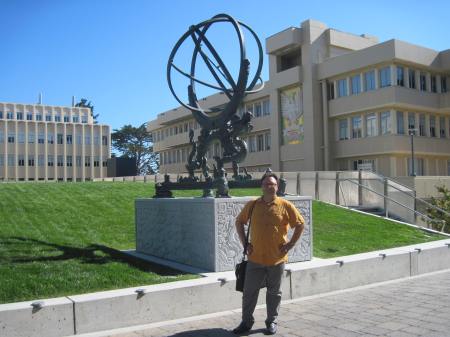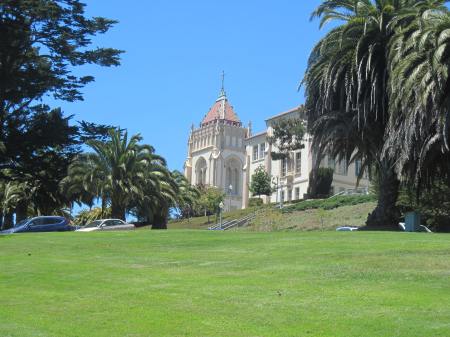Using Jesuit Archives for Chinese Military History
by Ken Swope

Dr. Ken Swope next to a replica of a Ming-era orrery that was built by the Jesuits for the Ming court. The original is at the observatory in Beijing. Photo courtesy of Ken Swope.
One of the great joys of any historian is finding new or under-utilized sources. And it’s even better when the sources are discovered in surprising places. For example most people would not consider Jesuit archives a prime place for locating primary source material on Chinese military affairs but a deeper understanding of the historical circumstances surrounding the early Jesuit missions to China reveals why this might be the case. Founded as part of the Counter Reformation, the Society of Jesus (Jesuit) order was designed to be the “front line” in Catholic conversion efforts, winning souls over for their side throughout the non-European world in the hopes of rolling back the surging Protestant tide in the early sixteenth century. To this end, the Jesuits were often highly trained in languages and the sciences and were expected to use their technical knowledge, especially in the realm of astronomy, to win over rulers and elites around the world and convince them, by extension, of the superiority of the Catholic message. Because of its massive population and ancient and sophisticated culture, China was viewed as a prime location for spreading the gospel. But because China already had a number of ancient religions and was polytheistic to boot, the Christian message wasn’t always the easiest to sell. However, just at the time the Jesuit efforts were expanding their effort, the Ming (1368-1644) empire was experiencing a series of military and political crises. While still preaching the word of God, the Jesuits found that their extensive scientific knowledge, in particular their knowledge of cannon casting, was of great interest to the Ming court and some of its high officials. Several found favor at the Ming court and a few high Chinese official even converted to Catholicism.
At the same time the few Jesuits in China became swept up in the events of their time. Thus it was that a pair of priests, the Portuguese Gabriel de Magalhaes and the Italian Ludovico Buglio, found themselves in Sichuan province in the early 1640s. At the time the province was racked by peasant rebellion and when the Ming capital of Beijing fell to the peasant rebel Li Zicheng in the spring of 1644, Sichuan fell under the control of Li’s longtime rival and sometime ally, Zhang Xianzhong, better known by his sobriquet, the Yellow Tiger. Zhang declared himself ruler of the Great Western Kingdom based in the provincial capital of Chengdu. Buglio and de Magalhaes were eventually brought before the king and impressed him with their scientific knowledge. Zhang made them favored advisers and even promised to build them a great church once he conquered all of China. In exchange they built him globes of Earth and the solar system and advised him on calendrical and astronomical matters. But over the next couple years Zhang’s enemies multiplied and he became increasingly paranoid, massacring tens of thousands of real or perceived enemies. Some outrageous accounts (dis)credit Zhang with exterminating up to 90 percent of the population of Sichuan province in just three years.

The Ricci Institute for Chinese-Western Cultural History at the University of San Francisco. Photo courtesy of Ken Swope.
Traditional Chinese sources tended to vilify Zhang as a madman with an unquenchable bloodlust. They contain lurid accounts of his delight in flaying victims alive and talk of the entire province reverting to a state of total chaos with tigers running rampant and humans turning to cannibalism to survive. Modern Chinese accounts from the communist perspective, on the other hand, tend to praise Zhang as a hero of the people who fought evil landlords to help the peasant class only to meet his end at the hands of the Manchu invaders. Fortunately for historians, de Magalhaes and Buglio chronicled their time at Zhang’s court and left a narrative of their experiences. This document was hidden away in Jesuit archives in Rome for centuries and was only rediscovered by scholars in the 20th century. The original is in Portuguese and a rough translation into English was made by a Jesuit priest in the 1960s. A copy was later sent to the Ricci Institute for Chinese-Western Cultural History at the University of San Francisco. Named for the Italian Jesuit Matteo Ricci, the institute was founded in 1984 as a non-profit interdisciplinary research center. Dedicated to studying the history of religious, philosophical, scientific, educational, and cultural exchange between China and the West with emphasis on the Jesuit missions to the Ming and Qing courts, the Ricci Institute supports visiting scholars, publishes books and articles, and sponsors symposia and seminars.
I had known about the Ricci Institute as a result of my general research interests in the history of the Ming dynasty and when I began working on my current book project, On the Trail of the Yellow Tiger: War, Trauma, and Social Dislocation in Southwest China During the Ming-Qing Transition, I decided to check out their holdings online and got in touch with Mark Mir, their outreach coordinator. I was thrilled to learn of the existence of the de Magalhaes narrative and the fact that the Ricci Institute had the only translated copy in existence. I also discovered that they have numerous rare Chinese primary and secondary sources pertaining to the late Ming more generally in addition to the Jesuit materials. Therefore I arranged a research trip to their beautiful campus in late June of 2015. While there I was able to examine this document as well as a number of obscure Chinese language materials. The information found in the diary is invaluable in providing a fairly unbiased assessment of Zhang Xianzhong’s strengths and weaknesses as a ruler, while also confirming some of the stories about his notorious excesses. I am excited about being among the first Western scholars to bring this document to light in my forthcoming research. And it goes to show that one can find incredibly valuable sources in the unlikeliest of places.
Ken Swope, Ph.D., is a senior fellow in the Dale Center for the Study of War & Society and the General Buford Blount Professor of Military History at the University of Southern Mississippi. His most recent book is The Military Collapse of China’s Ming Dynasty: 1618-44 (Routledge, 2013).
No comments:
Post a Comment
Comments always welcome!